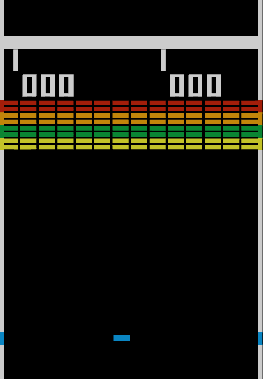In 1976, ATARI released a groundbreaking arcade game called Breakout. At first glance, it may appear to be just a simple brick-breaking game, but its release marked a major milestone in the evolution of video games.This article explores the historical background behind Breakout and explains its innovative game design in a beginner-friendly way.
The Early 1970s and the Dawn of Arcade Games
In the early 1970s, video games were still in their infancy. ATARI had already made waves in 1972 with its table tennis game, PONG, gaining significant attention in the budding game industry.
At the time, home consoles were not yet widespread. Games were played on coin-operated arcade cabinets. Breakout was developed in response to a growing demand for engaging single-player experiences.
The Development of Breakout
Breakout was designed as a single-player version of PONG. Unlike today’s games driven by software, early arcade games relied heavily on custom-built hardware circuits. Developers had to find creative ways to deliver compelling gameplay with limited resources.
The result was a game that offered not just reflex-based action but also demanded skill and strategy from players.
Gameplay and Innovation

Basic Rules:
- Use the paddle (bar at the bottom) to bounce the ball upward.
- Destroy the blocks (bricks) arranged at the top of the screen.
- Clear all the blocks to win the stage. Letting the ball fall results in a miss.
Innovative Gameplay Features:
- Angle Control: Where the ball hits the paddle affects its rebound direction, giving players precise control.
- Speed Variation: As the game progresses, the ball’s speed increases, ramping up the challenge.
- Satisfying Combos: When the ball enters the upper rows, it can cause a satisfying chain reaction as multiple blocks are broken in quick succession.
The Birth of a Genre
Thanks to Breakout’s success, the “block breaker” became a genre of its own. It inspired numerous spin-offs and successors, most notably Arkanoid by Taito.
Its influence extends beyond arcade halls, serving as the foundation for many puzzle and casual games that followed.
Why Play Breakout Today?
Breakout-style games are still playable today in browsers and mobile apps. Despite its retro appearance, the gameplay remains surprisingly deep and engaging.
The game’s focus on simple mechanics with strategic depth reflects a philosophy still relevant in modern game design.
Conclusion
Breakout is more than just an old-school game. It’s a creative achievement that overcame technological limitations to deliver timeless fun.
If you’re interested in video game history or just curious about where many of today’s game ideas began, give Breakout a try. You might be surprised how much fun it still is today!


Comments